I am currently using the STM32F4 with the STM32F429ZI Nucleo-144 Board. I am looking to use this microcontroller to evaluate the position of a rotary encoder via a quadrature encoder interface. Looking at the documentation, this is done with the timers. I have the A/B encoder outputs hooked up to PA6 and PC7 on the micro, but I have noticed that the counts appear to be drifting.
During the debugging, I noticed that if I disconnect one of the encoder outputs to the microcontroller and I move the motor, the counts still increment/decrement even though only one of the encoder lines are connected. Since I am counting on both the TI1 and TI2 edges, this should not be happening. If I am reading the below diagram correctly, since one of my lines is held high using the internal pull-up, clock pulses on the other input should be going up/down/up/down and really just cycling between two different counts. However, if I am rotating the encoder, the counts keep incrementing or decrementing depending on the direction.
Why is the encoder count changing with only one encoder input connected? I also have the scope trace attached to prove that only one count is is active, as well as the code.
EDIT: I have also tried changing the polarity from BOTH EDGE to RISING EDGE, with no perceived benefit.
#include "stm32f4xx_hal.h"
#include "encoder_test.h"
GPIO_InitTypeDef GPIO_InitStruct;
TIM_HandleTypeDef Timer_InitStruct;
TIM_Encoder_InitTypeDef Encoder_InitStruct;
void EncoderTest_Init()
{
__HAL_RCC_GPIOA_CLK_ENABLE();
__HAL_RCC_GPIOC_CLK_ENABLE();
__HAL_RCC_TIM3_CLK_ENABLE();
/**TIM3 GPIO Configuration
PA6 ------> TIM3_CH1
PC7 ------> TIM3_CH2
*/
GPIO_InitStruct.Pin = GPIO_PIN_6;
GPIO_InitStruct.Mode = GPIO_MODE_AF_PP;
GPIO_InitStruct.Pull = GPIO_PULLUP;
GPIO_InitStruct.Speed = GPIO_SPEED_FREQ_MEDIUM;
GPIO_InitStruct.Alternate = GPIO_AF2_TIM3;
HAL_GPIO_Init(GPIOA, &GPIO_InitStruct);
GPIO_InitStruct.Pin = GPIO_PIN_7;
GPIO_InitStruct.Mode = GPIO_MODE_AF_PP;
GPIO_InitStruct.Pull = GPIO_PULLUP;
GPIO_InitStruct.Speed = GPIO_SPEED_FREQ_MEDIUM;
GPIO_InitStruct.Alternate = GPIO_AF2_TIM3;
HAL_GPIO_Init(GPIOC, &GPIO_InitStruct);
Timer_InitStruct.Instance = TIM3;
Timer_InitStruct.Init.Period = 0xFFFF;
Timer_InitStruct.Init.CounterMode = TIM_COUNTERMODE_UP;
Timer_InitStruct.Init.Prescaler = 1;
Timer_InitStruct.Init.ClockDivision = TIM_CLOCKDIVISION_DIV1;
Encoder_InitStruct.EncoderMode = TIM_ENCODERMODE_TI12;
Encoder_InitStruct.IC1Filter = 0x00;
Encoder_InitStruct.IC1Polarity = TIM_INPUTCHANNELPOLARITY_BOTHEDGE;
Encoder_InitStruct.IC1Prescaler = TIM_ICPSC_DIV1;
Encoder_InitStruct.IC1Selection = TIM_ICSELECTION_DIRECTTI;
Encoder_InitStruct.IC2Filter = 0x00;
Encoder_InitStruct.IC2Polarity = TIM_INPUTCHANNELPOLARITY_BOTHEDGE;
Encoder_InitStruct.IC2Prescaler = TIM_ICPSC_DIV1;
Encoder_InitStruct.IC2Selection = TIM_ICSELECTION_DIRECTTI;
if (HAL_TIM_Encoder_Init(&Timer_InitStruct, &Encoder_InitStruct) != HAL_OK)
{
while (1);
}
if (HAL_TIM_Encoder_Start_IT(&Timer_InitStruct, TIM_CHANNEL_1) != HAL_OK)
{
while (1);
}
}
void TIM3_IRQHandler()
{
HAL_TIM_IRQHandler(&Timer_InitStruct);
}

